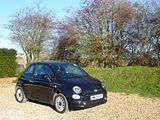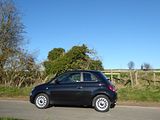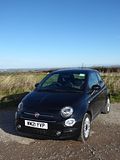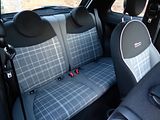When Fiat launched the production version of the 500 in 2007, a couple of years after receiving an exceedingly positive reaction to their visually similar “Trepiùno” concept car, I am sure they did not expect that the car would still be in production in almost unchanged form some 14 years later. But it is. And sales are as strong now as they have been throughout the model’s long life, with the model hitting 2.5 million sales in March 2021. Unashamedly trading on the cute looks of 1957’s Nuova 500, this 312-series 500 was an instant hit, with its design and style just screaming “want one” to many people, me included. A huge range of personalisation options were offered right from the outset and in the early years there were significant waiting lists, and a premium pricing for this small city car which must have had Ford wondering how they could get their rival, which shared all the bits you can’t see, so badly out of step with what the market wanted. Their second generation Ka never found much favour and faded from production pretty quickly whilst customers flocked to the Fiat showroom to buy a 500. When you get a design so right, as Fiat so clearly did with this car, you facelift it at your peril. Fiat only made the most minor changes in 2015 with new rear lights clusters with a central inset of body-coloured plastic being the most obvious external change, though if you look more closely you should also spot the redesigned grille and reshaped headlights incorporating daytime running lights with LED technology; revised 15″ and 16″ alloy wheels, new paint colours, and a rear bumper chrome strip with fog lights and that those new rear taillights feature integrated LEDs. Minor alterations inside adopted some of the detailed differences that had been seen in US market cars, even though the two remained distinct with the Mexican-built cars having a different front end to meet local crash protection requirements. There’ve not even been that many mechanical changes. The novel two cylinder Twin Air engine came in 2011, but fell foul of ever stricter emissions regulations and so went away again in 2018. There have been lots of limited editions and changes to the spec of the models offered ever since, but the only significant change to the Fiat version came in early 2020 with the announcement of mild hybrid technology. When the car was first launched the few Fiat 500s that were I the rental fleets were really hard to source but over the years, as the rental car companies have bought more and more of them, they are now a staple of the fleet, generally populating the cheapest smallest category of cars that they offer. When I handed the deeply disappointing Corsa to Mr Hertz, and had a back-to-back booking, and Hertz tried to give me another Corsa, I asked if they had anything else. All they would offer me was a one class downgrade (in their terms) to the latest spec Fiat 500. Having owned the related Abarth model for over 11 years and still loving it, I did not hesitate at all in saying that I would happily take the Fiat in preference to the hateful Corsa, pleased with the chance to renew my acquaintance with the Fiat version of the 500.
The main difference between this 500 and ones I have driven previously is the engine. Since the start of 2020, all Fiat 500s have been built with a 1.0 litre 3 cylinder “Firefly” engine with a mild hybrid assistance which in essence means an integrated Belt Starter Generator in conjunction with an 11Ah lithium-ion battery, with the system helping to run the car’s auxiliary functions. It’s mounted directly to the petrol engine and gives a very small boost under acceleration. The car does not run on battery alone, it always needs the petrol engine. This develops 70 bhp which by modern standards is not a lot, and in pure figures, the car is on the slow side, but actually the car feels quite zingy. There is a bit of turbo lag, but once the turbo is on boost, the torque will see you gain speed at a reasonable rate. You do still have to drive it hard to get the best out of it, though, something which the car feels well up to doing. It revs willingly, up to 4500 rpm without you really realising. It remains smooth and engine noise remains quite muted, even though a 70 mph motorway cruise is over 3000 rpm. The car does lose speed quite quickly on any inclines, though. Unlike its Abarth cousin, the Fiat 500 models come with a 6 speed manual gearbox. The gearchange is slick, with the angle, which is mounted in the lower half of the dash falling readily to hand. Sixth is only good when travelling over 50 mph, as is the case with so many cars, but it does help with that peaceful motorway cruise. It probably also helps with fuel economy, as does the stop/start system which is now included. I covered 300 miles with this Fiat 500 and it needed just 24 litres to fill it, which computes to an excellent 56.75 mpg. The other key figure is 88g/km CO2 emissions, which represents a 30 per cent reduction over the old 1.2 500.
It’s not reasonable to expect a Fiat 500 to drive like a less powerful Abarth, and in many ways, it does not. This version is engineered to be a city car and one that people buy because it is easy to drive, with many of these cars finding favour with people for whom it is their first car. Such cars are rarely much fun to drive, so it is to the Fiat’s credit that the 500 does better than that. The steering is light, but it does have some feel, though if you put it into City mode that will largely go in favour of making it a lot easier to undertake low speed manoeuvres. Early 500s were criticised for not being that sharp to drive, but Fiat fairly quickly made some changes to the suspension to improve the handling with the result that this car is now a predictable steer on twisty roads, with safe handling that will ultimately tend to understeer. The ride is much softer than that of the Abarth meaning that most will find this car comfortable enough on our patchwork quilt of road surface types, though it can still bounce around a bit. The brakes are strong and powerful. There is a traditional pull-up handbrake fitted between the seats. Visibility is generally good, as you sit nice and high and the car is easy to park, as it is so small and only has a short front end. Rear visibility is not so good with a limited view over the shoulder and thick C pillars.
The interior of the Fiat 500 is very familiar, as barring a few details, it has not changed throughout the entire production life of the model. You still get a retro-inspired look, with a single instrument-sized dial and a large expanse of coloured plastic in front of the passenger, which whilst not shouting luxury is very practical as it is easy to wipe clean. The steering wheel is not as chunky as the one you get in an Abarth but it is still pleasant to hold and in Lounge trim it is leather wrapped. The Fiat 500 did not get the TFT instrument display that went into the Abarth several years ago, so you still get the original design with a cleverly designed dial that has the speedometer around the outer of the dial and the revs inside that as concentric circles, with separate bar chart style gauges for fuel level and water temperature. The inner part of the display has a series of trip computer functions which you cycle through by pressing the button on the end of the right hand column stalk. There is now a new screen for the digital display in the instrument binnacle that shows the flow of energy either back into the battery when slowing down or to the wheels when accelerating, but the reality is that you actually never feel the system operating. Those column stalks handle lights as well as indicators and wipers. There’s no auto function for any of these. The centre of the dash was changed in 2015 when the only significant facelift arrived with a new uConnect touch screen replacing the old Blue & Me system. The graphics are crisp and the system is responsive and easy to use, though it is really only used for audio functions even in this top spec Lounge model. Some specs will give you a navigation system integrated into this unit, but that was not the case with this Lounge spec model. So that means that the screen is really just DAB radio, Android Auto and Apple Car Play. Beneath this are the controls for the manual air-conditioning control, which are the same as I had in my first Abarth.
By modern standards, the Fiat 500 is a small car, but even so there is a remarkable amount of space in the front seats. They’re mounted quite high off the floor, which creates a vast amount of legroom, yet there is plenty of headroom as well. The trade-off is a bolt-upright driving position that won’t suit everyone. It’s also a narrow car, so shoulder room is at a premium. The seats themselves look quite flat, but they are surprisingly comfortable and they come trimmed with a nice colourful upholstery which adds to the sense of style and fun that is a defining characteristic of the car. Lounge trim includes a glass roof panel which makes the cabin nice and light.
There are only two seat belts in the back of the 500 and they don’t offer that much space. There’s enough for someone less than five feet tall, but anyone much larger than that will feel cramped by the lack of legroom and headroom. Most will want to pull the headrests well up, as otherwise may find them brushing against your shoulders. Each back seat has a pair of Isofix mounts, but installing a bulky child car seat takes careful manoeuvring and of course, as a three door car (one of few still on sale), access is a bit tricky as only the seat backrest tilts forward meaning there is quite a narrow space through which to gain access. There’s not much in the way of oddment space here, with just a central cup holder on the floor at the back of the console unit.
With a total capacity of just 185 litres, the boot does not sound very spacious. It is not the smallest you’ll find in a city car, but equally nor is it a match for rivals such as the Kia Picanto. Experience with the Abarth models has taught me that even with a few odds and ends that live in the car, you can still get several shopping bags or a couple of carry-on suitcases in, but that is about it. At least the opening is large and square, so it’s easy to drop bags in. The rear seats fold down if you need more luggage space. Indeed it’s not unknown for owners to treat the Fiat 500 as a two-seat car and leave the back bench permanently folded. In that format, the 500 becomes a lot more practical. On Lounge spec models, the rear seat backrests are split on a 50/50 basis, which will free up mode luggage space, though when you do just drop the backrest down, the resulting load bay is not completely flat. There is a bit of space under the boot floor for bits and pieces. Inside the cabin, you now get a proper glovebox which took the place of the open parcel shelf, and there are long but narrow door pockets, as well as cupholders in the centre console.
During its long production life there have been literally countless different trim versions of the Fiat 500, many of them limited edition cars, such as the Diesel, the Gucci, the Riva, the Collezione and the 1957 edition to name just a few. Even the trims and the names used for them for the regular cars have changed many times, though two have endured right from the outset: the Pop at the bottom of the range and the Lounge as a rather more plushly trimmed version. For 2021, Fiat revised the model versions again. The Pop trim provides the most affordable entry point into the 500 range. The family’s colour palette is broadened by the new, exclusive Sicilian orange livery, complemented by new fabric blue seats, embellished with the FIAT monogram and a dedicated dashboard in new Techno blue. There’s not much in the way of standard equipment here though you do get a DAB radio operated through the uConnect touchscreen, and there is a USB port. The 500 Pop costs from £13,270. Lounge spec gives you a panoramic glass sunroof, rear parking sensors, a chrome front grille, front fog lights, a leather-trimmed steering wheel and the rear seat backrest is split 50/50. The Connect trim level offers a high level of technology as standard, with the 7-inch Uconnect infotainment system with DAB radio, Apple CarPlay™ and Android Auto™. On all three models, new seats are paired with a brand-new dashboard finish in matt silver. The standard features on the 500 Connect also include cruise control, parking sensors, sports steering wheel with audio controls, 15-inch alloy wheels and fog lights. It is available in the exclusive new Perbene grey/Vesuvius black two-tone livery. 500 Connect is priced at £15,000. The 500 Dolcevita builds on the Connect specification while harking back to the Nuova 500 when it was launched in 1957 with its glamorous style and fine aesthetic details. The interiors include body-colour dashboard, while outside chrome-plated details, a glass sunroof, 15-inch alloy wheels and the Dolcevita badge complete the exterior changes. A two-tone livery is optionally available alongside Bossa Nova White and Lunar Grey paint. The 500 Dolcevita is priced from £15,000. The 500 Dolcevita Plus adds further to the Dolcevita specification with automatic climate control, 7-inch TFT screen, 3D satellite navigation and 16-inch alloy wheels. It is priced from £16,500. The top of the range is the Sport trim is enhanced by the optional matt grey paint, and dedicated Sport badge. As standard, 500 Sport receives 16-inch alloy wheels, new electric heated seats, automatic air conditioning, new titanium colour dashboard, 7-inch TFT screen and privacy windows. It is priced from £16,500. The distinct character of the trim levels can be further enhanced to customise the 500 family even more, while offering significant financial saving. These include: the Magic Eye Pack: includes front parking sensors and rear camera, NAVI pack and ADAS pack with Blind Spot Detection and Adaptive Cruise Control. Available on Connect and Cross; the Comfort Pack: includes automatic air conditioning and adjustable seats, visibility pack with xenon headlights, electrochromatic rear view mirror and dusk and rain sensors. Available on Pop, Cross and Sport, the Style Pack: includes chrome-plated details and privacy glass with the full-LED pack Available on Connect.
If you really want the very latest sophistication from a swish touch-screen, or all the latest safety features (including the irritating ones, like Lane Keep Assist that we all want to turn off), then a Fiat 500 is not for you. But if you are charmed by its style, and want a small city car that you can also take on long journeys, that will put a smile on your face, that you will enjoy looking at, and which does not cost that much to buy or to run, then the Fiat 500 has much to commend it. There can’t be many cars that can claim that 14 years after their market launch, showing how this Fiat not only deserved its Car of the Year award that it picked up in 2008, but that the Italians still can appeal to the heart as well as the head with their small cars.

































































